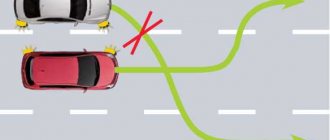“An extra passenger” is usually called a person who is in a vehicle when all the seats that were included in the design by the manufacturer are already occupied by other people.
Transporting an extra passenger in 2021 is an administrative offense for which the perpetrator will be held accountable and required to pay a fine to the traffic police. Many car owners imprudently classify this act as insignificant, although it certainly negatively affects the safety of the trip and can aggravate the severity of the consequences of a traffic accident. The violation is common among both drivers of passenger vehicles and buses.
Attention! If you have any questions, you can chat for free with a lawyer at the bottom of the screen or call Moscow; Saint Petersburg; Free call for all of Russia.
What is the fine for an extra passenger?
Transporting passengers in quantities exceeding the norm is one of the options for violating the rules for transporting people. The punishment for an extra passenger in 2021 is determined by the first part of Article 12.23 of the Code of Administrative Offenses of the Russian Federation - an administrative fine of 500 rubles.
A fine of 500 rubles will also be imposed on a citizen driving a bus if the number of people on board exceeds the number of seats when driving along an intercity, mountain, tourist or excursion route.
If in 2021 a driver is detained carrying an “extra passenger” outside the cabin of a vehicle, his act will fall within the meaning of Part 2 of Article 12.23 of the Code of Administrative Offenses of the Russian Federation. For this, the legislator determined a different fine amount - 1000 rubles. The sanction will be much stricter if the act complies with the disposition of the third or fourth part of the article of the administrative code under consideration.
In accordance with them, if the violation concerns the transportation of a child, and also if the number of passengers exceeds the number of equipped seats during the organized transportation of a group of children, the punishment varies depending on the subject: the driver will pay a fine of 3 thousand rubles; guilty official – 25 thousand rubles; legal entity – 100 thousand rubles.
Legislation
The operation of buses for transporting passengers is regulated by a huge number of regulations. The main ones are:
- Federal Law “On Road Traffic Safety” - defines the general requirements for the driver, the general rights and responsibilities of all road users.
- Federal Law No. 220 of July 13, 2015, regulating regular transportation.
Government Decree No. 1090 of October 23, 1993. This document approves not only the Traffic Rules, but also such an important document as the Basic Provisions for the admission of vehicles to operation.
These documents define the fundamental principles that every traffic participant, including bus drivers and passengers, need to know.
“Charter of Road Transport and Urban Ground Electric Transport” - this document is a Federal Law; it establishes general rules that organizers of passenger transportation must follow.
Transportation rules approved by Government Decree No. 112 of February 14, 2009. True to its title, the document details some of the regulations that carriers must follow.
Rules for the transportation of children, approved by Government Decree No. 1177 of December 17, 2013, regulating in detail the requirements for documents, drivers, vehicles and general standards for this category of passengers.
Order of the Ministry of Transport No. 7 dated January 15, 2014, approves the rules for transportation so that they meet safety criteria.
A number of documents that will be mentioned later in the text, establishing separate rules for drivers undergoing examinations, instructions, establishing the procedure for undergoing medical examinations, obtaining a license, etc.
When is a passenger considered unnecessary?
The rules regarding the transportation of people by road are primarily set out in the provisions of Chapter 22 of the Road Traffic Rules. In the context of the problem under consideration, it is necessary to determine:
- what kind of vehicle are we talking about (bus, car, etc.);
- route (for route vehicles);
- whether the “extra passenger” is a child;
- whether the required violation was committed during the organized children's bus transportation.
Clause 22.8 of the Russian Traffic Regulations outlines a ban on transporting people “in excess of the number provided for by the technical characteristics of the vehicle.”
If a car has a total of five seats equipped with seat belts, then the driver and four passengers can travel in it. Carrying a fifth person is prohibited, even if the back seat is large enough to accommodate everyone. In 2021, carrying a child on the lap of one of the adults is also unacceptable.
Another example. As mentioned above, when designing a bus, the manufacturer can provide a certain number of standing places. In some cases, passengers can ride standing if necessary, but if the driver takes more standing passengers than the manufacturer provided, these will also be “extra passengers” for whom a fine will be imposed.
In 2021, the law defines situations where any passenger left without a seat will be redundant. Clause 22.3 of the Traffic Regulations of the Russian Federation establishes that the number of people transported in the cabin when traveling along an intercity, mountain, tourist or excursion route and during the organized transportation of a group of children should not exceed the number of seats equipped for seating. Those. In these cases, riding while standing is prohibited.
Types of transportation
Classification of transportation occurs depending on the distance of destinations and the category of passengers.
The first group includes such types of transportation as:
- city traffic, when buses run within a populated area;
- suburban. According to the rules of Art. 4 Federal Law No. 259 dated November 8, 2007, this category includes buses running between settlements located no further than 50 km from each other;
- intercity. The distance in this case between points exceeds 50 km;
- international. A special feature of this message is crossing the border of the Russian Federation, including transit through Russia.
Depending on the organization of transportation, they are divided into:
- regular. That is, those that are carried out constantly along a predetermined route, at a certain time, agreed with local authorities, intended for the transportation of any passenger who has paid for the fare;
- custom. This type represents the transportation of a specified group of passengers on the basis of an agreement concluded with their representative;
- transportation by passenger taxi. This species has a number of features established by Federal Law No. 69 of April 21, 2011.
They are assigned to a separate group for transporting children. This is due to the presence of a large number of requirements and separate rules provided for the movement of groups of this category.
How to understand how many passengers transport is designed for in 2021?
The number of seats and their location are determined by the manufacturer. You should find the operating manual for your specific model; this information must be indicated there. Particular attention is paid to this issue during commercial transportation, since data on the number of passenger seats is also transmitted to the Tax Service. In some situations, it is impossible to do without an examination.
For an ordinary citizen who is sure that the previous owners have not made any changes to the design of his modern passenger car, it is usually enough to focus on the number of seats equipped with standard seat belts.
Procedure for imposing a fine
In order to bring the offender to justice in 2021, an authorized police officer needs to stop the car and identify the fact that there is an extra passenger in it. The reason for the stop may be any other traffic safety offense committed by the motorist. Transport without visible violations may also be stopped. For example, this is possible if a special preventive measure is carried out in a certain area, or if the vehicle matches the description in the orientation. Further, in common practice, an attentive inspector notices that there are a suspiciously large number of people.
If the traffic inspector has established the fact of a violation in the form of transporting an extra passenger, he will begin the procedural registration of the event. In this case, a simplified process is provided; the official is allowed to make a decision on the spot. If the driver does not challenge the fine for an extra passenger, the inspector will issue a decision on the case of an Administrative Offense, and will indicate the measure of responsibility.
If the motorist does not agree that his actions were contrary to the norms, then a protocol will be drawn up on the case of an Administrative Offense, which will indicate the place and time for further consideration.
After filling out the necessary papers, the driver receives a copy of the protocol on the imposition of a fine for the extra passenger and can continue driving, but the violation itself must be eliminated. Otherwise, the offender may be detained again.
Driver requirements
Like any driver who gets behind the wheel of a vehicle, a bus driver must have a license obtained upon fulfilling the conditions established in Art.
26 Federal Law “On Road Safety”. That is, to reach the age of 21, undergo training, and have a medical report on the possibility of obtaining a document. This certificate must be category D.
All persons allowed to drive vehicles engaged in mass transportation of people must undergo instructions, professional training and a health check.
In accordance with Art. 20 of the Federal Law “On Road Traffic Safety”, a legal entity or individual entrepreneur that hires a driver, before releasing him on a flight, is obliged to check his state of health, including examining him for the presence of alcohol or psychotropic substances in his blood.
The procedure for conducting such events must comply with the requirements of the law established in Order of the Ministry of Health No. 835n dated December 15, 2014.
In addition, all drivers must undergo medical examinations in special organizations, according to the rules and within the time limits determined by Order of the Ministry of Health and Social Development No. 302n dated April 12, 2011.
Even higher demands are placed on bus drivers transporting children. They can only be people who have at least 1 year of driving experience in the corresponding category; during this year they should not have committed administrative offenses in the field of road safety, for which they would have been given punishments such as deprivation of their license or arrest.
Who is responsible for the extra passenger in 2021?
Only the driver can be the subject of the violation in question. The person who was behind the wheel and operating the vehicle will be fined for an extra passenger. He is responsible for the safety of transportation and its compliance with established standards.
Taking into account the fact that the extra passenger is most likely in the car, unable to fasten a seat belt, he may also be charged with a fine, but under a different article. For violation of traffic rules by a passenger, the punishment is determined by part 1 of Article 12.29 of the Code - 500 rubles. administrative fine. Let us add that a motorist may also be fined 1,000 rubles, which is prescribed under Article 12.6 of the Code for transporting people without using seat belts.
Judicial practice under Article 12.23 of the Code of Administrative Offenses of the Russian Federation:
Supreme Court decision: Resolution N 88-AD17-1 of 06/05/2017 Judicial Collegium for Administrative Cases, supervision
Supreme Court decision: Resolution No. 10-AD14-7 of July 15, 2014 Judicial Collegium for Administrative Cases, supervision
Decision of the Supreme Court: Determination N 44-G09-13 of 07/08/2009 Judicial Collegium for Civil Cases, cassation
Supreme Court decision: Resolution N 45-AD17-1 of 02/16/2017 Judicial Collegium for Administrative Cases, supervision
Supreme Court decision: Resolution No. 16-AD13-3 of 07/09/2013 Judicial Collegium for Administrative Cases, supervision
Supreme Court decision: Resolution No. 2-AD11-4 of 08/18/2011 Judicial Collegium for Administrative Cases, supervision
Supreme Court decision: Resolution N 44-AD15-1 of March 24, 2015 Judicial Collegium for Administrative Cases, supervision
Supreme Court decision: Resolution No. 9-AD17-1 of 03/06/2017 Judicial Collegium for Administrative Cases, supervision
Decision of the Supreme Court: Determination No. 18-G09-3 dated March 18, 2009 Judicial Collegium for Civil Cases, cassation
Supreme Court decision: Resolution No. 19-AD15-10 of 08/12/2015 Judicial Collegium for Administrative Cases, supervision
- First
- «
- Last
Comments ()
Write a comment
What should a driver do if a traffic inspector imposes a fine for an extra passenger?
When communicating with a police officer, the driver should be correct and strive to understand the situation. If he realizes that he has committed a violation, he should calmly fill out the paperwork and then pay a fine for transporting an extra passenger. If you are confident that the actions of the traffic police inspector are illegal, a citizen can exercise the right to conduct audio and video recording. Then you should record your comments in the protocol on the case of an Administrative Offense, which will be drawn up in the event of a dispute.
The driver has the right to completely refuse to put his signature on the protocol, but then in the presence of attesting witnesses this is noted, and the refusal does not affect the further procedure in any way. If a decision has been made, the citizen can also appeal it.
Under what conditions is the carriage of passengers prohibited?
About when the transportation of passengers by motor transport is prohibited, it is stated in subsection 22.8 of the Traffic Regulations of the Russian Federation:
- You cannot seat people outside the cab of a vehicle unless it is an equipped flatbed truck or a box body;
- it is unacceptable to place them for travel outside the cabin of a tractor or other self-propelled equipment, on a trailer intended for cargo;
- passengers cannot be placed outside the seats of the bike, in the back of a cargo motorcycle;
- It is not allowed to transport them standing if the technical parameters of the transport are such that this does not allow this.
There are also conditions under which passengers cannot be carried in other traffic rules:
- it is prohibited for a driver without category C or C1 license or with it, but obtained less than 3 years ago, to put them in the back of a truck;
- You cannot take 8-16 passengers in the back of a truck if there is no D or D1 mark;
- It is unacceptable for a motorcyclist or moped to take passengers if he received his driving license less than 2 years ago;
- You cannot carry a child under 12 years of age without an age-appropriate secondary restraint;
- transportation of standing people is prohibited if the design of the vehicle does not provide for this (minibuses, etc.);
- It is unacceptable to place a passenger under 12 years of age in the back seat of a motorcycle.
Watch this video about the rules for transporting people:
Is there a discount?
In 2021, a driver can save exactly half the amount of the fine imposed for an extra passenger if he makes payment within the next twenty days following the day the decision was issued. This opportunity is provided by Article 32.2 of the Administrative Code. This benefit does not apply to a number of gross violations. Exceptions are indicated directly in the norm; there is no fine for transporting an extra passenger among them. In any case, penalties must be paid off within 60 days to avoid additional costs for late payment (Article 20.25 of the Code of Administrative Offenses of the Russian Federation).
What does “violation of the rules for transporting passengers on a bus” mean?
Violation of the established rules for transporting passengers on a bus means, first of all, ignoring any of the above conditions, but also:
- lack of a license for this type of activity, driver’s license of the required category and experience;
- failure to undergo a pre-trip medical examination;
- inconsistency of transport with the purpose of use;
- unjustified deviation from the established route;
- discrepancy between the number of passengers and the technical capabilities of the bus.
For this, not only the driver is punished, but the head of the company organizing the transportation, or the owner.
Watch this video about who must have a license to transport passengers:
Appealing a fine for an extra passenger
The citizen has 10 days from the day he was given a copy of the decision to appeal it. If this deadline is missed, the period for appealing the fine for an extra passenger can be resumed if there are compelling reasons.
The main stages of appealing a fine for an excess passenger in 2021 can be outlined as follows:
- searching for arguments in one’s favor, collecting material;
- determination of the place of consideration;
- drafting the text of the complaint (sample attached);
- checking its correctness and reliability of data;
- sending the document to the addressee;
- taking part in the review.
Applications to appeal the fine for an extra passenger can be found here.
Let's look at these stages in more detail.
- It is necessary to select arguments that will convince a judge or an official at the State Traffic Inspectorate that the decision imposing a fine for an extra passenger really needs to be canceled. You should collect all available materials that confirm the case. This could be a video recording that shows that there is a permissible number of passengers in the cabin, but the police officer is acting illegally. Perhaps a document was found certifying that changes to the car’s design were made according to the rules, or an operating manual that confirms the driver’s correctness. In 2021, a gross error in the document, such as incorrectly specified data on the vehicle model, may also be grounds for canceling the resolution.
- It is necessary to select the body where the complaint will be considered. If the contested decision was made by an employee of the State Traffic Inspectorate, you can appeal to a higher authority, a higher official, or a district court. It is permissible to send the application to all addressees at the same time, but then only the judge will have the right to deal with the case. When choosing a court, you need to focus on the place where the violation was discovered. The data specified in the resolution will help determine the required unit of the State Traffic Inspectorate. Even in the event of an error in the choice of an official or court, the complaint must be forwarded to the jurisdiction within three days without the participation of the citizen. For the traffic police unit, the period within which they are required to make a reasoned decision is limited to ten days, calculated from the moment it receives all the materials. For a judge it is much longer - two months. Some citizens fear that traffic police officers are less impartial than judges and prefer to wait longer.
- Draw up a complaint with an application to appeal the fine for an extra passenger according to the proposed sample - by hand or on the computer. The necessary information about the inspector is indicated in the disputed document itself. The text must be correct, legible, and not contain rude words. It is necessary to indicate the applicant’s details; such a complaint cannot be anonymous.
- After compiling the text, it would be a good idea to double-check it and make sure that the facts are not distorted. An inspector may be present at the examination, and he may have a video or audio recording that the offender did not know about.
- The finished document can be sent by registered mail or delivered directly to the addressee. In 2021, the departments of the State Traffic Inspectorate have special sealed boxes for receiving citizens' requests; you can contact the office or secretariat.
- After waiting for an answer, you should appear for consideration to personally defend your position. In some cases, the procedure can be carried out without the applicant. The decision on the complaint will be announced immediately and can also be appealed to a higher authority. In a difficult situation from a legal point of view, the assistance of a lawyer will be useful at each stage of appealing a fine for an extra passenger. It will not be difficult for a person who is confident in his rightness and knowledge to get the illegal decision overturned on his own.
How to avoid a fine, and what are the dangers of incorrect transportation?
The best and at the same time the only legal way to avoid liability for transporting an extra passenger is to prevent this offense. The driver must carry only the number of passengers provided by the manufacturer. This is primarily a question not of convenience, but of safety, since such a violation entails an increase in the severity of the consequences in the event of an accident.
An additional person in a passenger car is prevented from using a seat belt. For a child who is placed on an adult's lap, the risk of severe injury or death increases significantly. Many examples of road accidents can illustrate that an adult is not able to hold a child, but often causes damage with the weight of his own body. Even taking into account that many rear seat passengers are generally not inclined to use seat belts, the presence of another unsecured body in the cabin during a severe impact and/or rollover will increase the damage to the health of the victims.
Some unscrupulous owners of buses and minibuses used for commercial transportation try to illegally increase the passenger capacity of their vehicles for profit by simply adding one or more seats. Changing the design of a vehicle, as it should be, is a rather expensive and time-consuming process. But there will be more confidence in the compliance of the characteristics of the new chair with safety requirements. A passenger on a bus or minibus who receives a poorly installed seat, added without permission by the car owner, may suffer more significantly in an accident than others.
Rules for transporting passengers on intercity buses
The rules for transporting passengers on any type of intercity bus require the following conditions to be met:
- complete technical condition;
- availability of a certificate of conformity and a waybill for the driver;
- the ability for people to know the route, buy a ticket at the ticket office or pay the driver during a stop;
- the seats should be of increased comfort;
- access is provided for people to emergency and emergency exits (they are indicated by an inscription);
- there must be a spacious luggage compartment;
- use of a symbol indicating the departure point and destination at the bottom of the windshield;
- the driver has a recorder and navigator;
- assistance to passengers in stowing luggage;
- announcement of intermediate stops, if there are any along the way;
- driver assistance for passengers with disabilities;
- boarding and disembarking only after the vehicle has stopped;
- movement with doors closed and after people are seated;
- notifying them in case of danger.
It's not just the person driving the bus who has responsibilities. Passengers also follow the rules:
- buy a ticket in advance;
- place their belongings in the cabin so as not to disturb others;
- occupy the seat indicated on the ticket;
- do not smoke, do not drink alcohol in the cabin, do not interfere with the driver;
- do not transport dangerous or bad-smelling contents;
- They also take care of their own safety (wear a seatbelt, don’t lean out of the window, etc.).











